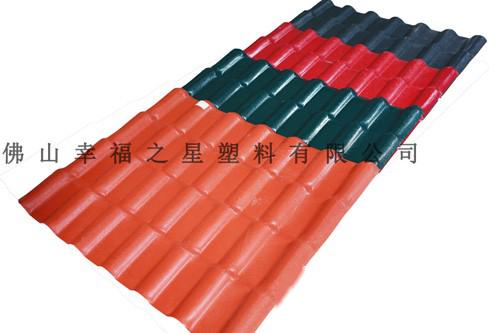Features: 1. Weather Resistance Synthetic resin tiles are generally made from high-weather-resistant engineering resins such as ASA, PPMA, PMMA, etc. These materials are highly weather-resistant, allowing them to maintain exceptional weather resistance in natural environments. They can remain stable in color and physical properties even when exposed to ultraviolet rays, moisture, heat, cold, and impact over long periods.
2. Excellent Corrosion Resistance
High-weather-resistant resins and the main resin have very good corrosion resistance. They are not eroded by rain and snow, which leads to performance degradation, and can withstand long-term corrosion from various chemical substances such as acids, alkalis, and salts. Therefore, they are highly suitable for coastal areas with strong salt spray corrosion and regions with severe air pollution.
3. Outstanding Load-Bearing Performance
Synthetic resin tiles have excellent load-bearing performance.
4. Good Impact Resistance and Low-Temperature Performance
Synthetic resin tiles have good impact resistance and low-temperature capabilities. A 1-kilogram steel hammer dropped from 1.5 meters onto the tile surface does not cause cracks. After 10 freeze-thaw cycles, the product shows no signs of delamination, bubbling, peeling, or cracking.
5. Self-Cleaning
The surface of synthetic resin tiles is dense and smooth, making it difficult to attract dust, exhibiting the “Lotus Leaf Effect”. Rainwater washes it clean as new, avoiding the phenomenon of dirt accumulation that results in mottled appearances after rain.
6. Easy Installation
This type of product generally has the following characteristics:
Large single tile area, high installation efficiency
Lightweight and easy to lift and remove
Complete range of supporting products
Simple tools and processes
7. Green and Environmentally Friendly
Synthetic resin tiles have passed theChina Environmental Labeling Product Certification, and can be completely recycled and reused at the end of their service life.
8. Fire Rating Reaches B1
Complies with national fire protection requirements for roofing materials, achieving a flame-retardant standard that effectively delays the spread of fire.
Installation Requirements: The purlin can be made of square tubes, C beams, or anti-corrosion wood.
Purlin spacing: 660mm and arranged from bottom to top.
Main tiles should be installed against the local prevailing wind direction, overlapping one wave.
Drill holes first, then secure with screws. The hole diameter should be 2mm larger than the screws, typically using 6mm diameter screws.
Common Accessories:
A Ridge Tile: Length 1050mm, Actual Length 960mm
B Sloped Ridge Tile: Length 1050mm, Actual Length 1020mm
C Sloped Ridge End Cap: Length 150mm
D Ridge End Cap: Length 300mm, Width 90mm, Height 220mm
E Drip Edge: Length 1050mm, Actual Length 960mm
F Three-Way Connector: 160mm*180mm*180mm
G Eave Board: 220mm*5=1100mm (plus 30mm interface edge length)













